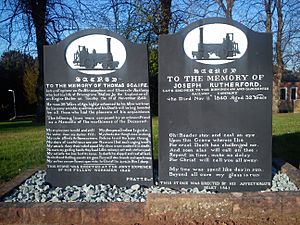St John the Baptist Church, Bromsgrove facts for kids
Quick facts for kids St John's Church, Bromsgrove |
|
|---|---|
| St John the Baptist Church, Bromsgrove | |

Church of St John the Baptist, Bromsgrove
|
|
| 52°20′02.8″N 2°3′52.6″W / 52.334111°N 2.064611°W | |
| Location | Bromsgrove |
| Country | England |
| Denomination | Church of England |
| Website | St Johns Bromsgrove |
| History | |
| Dedication | St John the Baptist |
| Administration | |
| Parish | Bromsgrove |
| Deanery | Bromsgrove |
| Archdeaconry | Dudley |
| Diocese | Diocese of Worcester |
The Church of St John the Baptist in Bromsgrove is a very old and important church. It is a Grade I listed building, which means it's considered a special historical place. It belongs to the Church of England.
Contents
A Look Back in Time
This church was part of a very large area during the early Norman times. Around the 1200s, King Henry III gave the church and its lands to Worcester Priory. This was done to remember his father, King John I, who is buried there. The Priory then managed the land and collected money until a time called the Dissolution. After that, the land went to a new group called the Dean and Chapter.
In 1643, during a difficult time in England, King Charles I ordered that the church's vicar, John Hall, be removed. There were many arguments about who should be the vicar for years. John Hall returned as vicar until 1652. The next vicar, John Spilsbury, was not liked by everyone. He was later removed when the King returned to power in 1660. Spilsbury refused to follow new church rules and was even put in prison for his beliefs. He later returned to Bromsgrove and became a teacher.
About the Church Building
The church building itself started being built in the 1100s. However, most of what you see today was built in the 1300s and 1400s. It was repaired and updated in 1858 by a famous architect named George Gilbert Scott.
Inside the church, you can find beautiful stone carvings from the 1200s and early 1500s. There's also a special stone statue from 1517 in the main part of the church. In 1855, this church helped build Holy Trinity Church, Lickey as a smaller church nearby for people to use. Records show that church bells have been here since the 1690s, and a clock was first mentioned in 1684.
Remembering Heroes: The War Memorial
Inside the church, there is a large metal memorial. It lists the names of men from Bromsgrove who died in the First World War. One of the names is Captain Noel Chavasse. He was a medical doctor and an Olympic athlete. He is one of only three people ever to be given the Victoria Cross medal twice for his bravery.
Famous People Buried Here
Several important people are buried at St John's Church:
- Sir Humphrey Stafford and his wife Eleanor
- Gilbert Talbot (soldier) and his first wife, Lady Elizabeth Talbot
- John Talbot (died 1549) and his wives Margaret and Elizabeth
The Church Organ
The church has had an organ since at least 1808. A small one was put in by Thomas Elliot. Over the years, the organ has been rebuilt and improved many times. Today, it is a large pipe organ with three keyboards and foot pedals. You can find details about this organ on the National Pipe Organ Register, which keeps track of church organs.
Past Organists
Here are some of the people who played the organ at the church:
- James Simms (1809 - 1854)
- J. B. Tirbutt (1854 - ????)
The Churchyard and Its Stories
In the churchyard, you can find the graves of two railway workers, Thomas Scaife and Joseph Rutherford. They both died in a sad accident on November 10, 1840. The boiler of a train engine exploded at Bromsgrove station. Their gravestones have pictures of steam trains carved into them. However, the train in the pictures is not the exact one that exploded.
See also
 In Spanish: Iglesia de San Juan Bautista (Bromsgrove) para niños
In Spanish: Iglesia de San Juan Bautista (Bromsgrove) para niños


